(1) To present the RIAA dimensional spec for 7-inch Large-Hole vinyl record singles, specifically the part of the spec related to CENTER HOLE EDGE THICKNESS; and
(2) to present a reason why It's A Good Thing For Plants To continue to remain Compliant With That PArt Of The Spec IF POSSIBLE, if selling records to the USA market.
It's understood (per an earlier brief exchange I had with Mossy) that there can be conflicts of interests, such as record buyers demanding thicker pressings, and, depending on availability of press molds, the possible inability to make a thicker 7-inch playing surface while maintaining the same thinner At-Spec 45 rpm large-center-hole edge thickness.
I am presenting here, for anyone who's interested, my argument on the side of Maintaining The RIAA Dimensional Spec For Center Hole Edge Thickness Whenever Possible. THE MAJORITY of 7-inch large-hole 45's on the market STILL DO, from what I've seen as a vinyl buyer.
I'm sure many would wonder, "why would anyone care" -- thus, this post.
==================================
It occurred to me, something that people outside the USA probably don't know about - and by now, probably lots of people in the USA don't know about either:
We all probably know that the 7-inch 45 rpm record format was invented in US by RCA Victor in 1949, with a large center hole, approx. 1.5-inch-diameter.
What many folks may not know, atleast folks outside of USA: RCA introduced, along with the 45 rpm large-hole format, the first 45 rpm turntables, which were ALL Drop-Stack Changers: None of this First Wave of 45 rpm turntables were manual single-play turntables; they were ALL automatic, all made by RCA:

These used a larger center spindle with 2 pairs of knife blades, which were spaced apart the perfect thickness for their design of the 45 rpm record dimensions. One after another, the knife blades would alternate coming in & going out, droping each record one by one onto the turntable for play.

The records had to be pressed with the correct center hole thickness and correct contour in the label area, to work properly on these types of changers.
This "45" format, and these RCA players, were Promoted Very Hard by RCA in the US, even to the point that RCA gave away a number of these automatic "45" players for FREE. RCA was desparate to get their new 45 rpm format and players into everyone's home. It worked, and this Large-Hole 7-inch 45 rpm format "TOOK ROOT" in the US. Of course, all other home record-player manufacturers jumped in to produce similar drop-stack players, most of which could play BOTH the normal small-hole format 33 rpm & 78 rpm records, AND the Large-Hole RCA 45 rpm format.
 .
.  .
.  .
.  .
.  .
.  .
. 
In the USA, in the 1950s up through the very early 1980's (when they went out of style), there were a TON of home players made to be Automatic Drop-Stack players, with large-hole "slicer" automatic spindle attachments for stacking large-hole 45 rpm records.
Other countries (wisely, I would say) ignored the whole foolishness of using a different larger-sized center hole for 7-inch 45 rpm singles, and stuck with the same standard smaller center hole for 7-inch discs. But Not in the USA. Here, the large-hole 45 became Standard, and became part of the RIAA's Dimensional Standards for US 45 rpm production, published October 16, 1963: This was an agreement between record pressers and these US automatic drop-stack changers, to ensure that the dimensions of the discs would be Within Certain Tolerances, and that the makers of the machines designed their spindles to work with the same thicknesses. That way, all brands of Records made in the US, would work properly with all manufacturers brands of these large-hole autmatic drop-stack changers popular during the 1950s-1970s in USA:
RIAA spec - see Bottom Right of diagram in this link: 45 rpm large center hole thickness specification of 0.030 (+/- 0.006) inches:
http://www.aardvarkmastering.com/riaa-4.gif
The DEFINITE MAJORITY of large-hole 45's on today's market (I buy a lot) are still compliant with that spec.
The purpose of this post is to share with everyone worldwide, a reason Why It's A Good Thing For Plants To CONTINUE to REMAIN Compliant With That Spec WHEN POSSIBLE, if selling records to the USA market: because those old players were so well-built, a lot of them still work, and a lot are restored as a major hobby, so many people still use them. (See below for examples.)
I've restored vintage players for over 20 years. Although the RIAA spec dictates a 7-inch 45 rpm large-hole center hole thickness of 0.030 (+/- 0.006) inches, all my restored stacker players (different makes & models) seem tolerant of thicker discs until about 0.040 inches, then they start malfunctioning. Some of players have "spring-loaded" slicer blades, so if a record has a center hole thickness of 0.040 inch or more, the disc just doesn't drop. On some players, such a disc drops halfway, and then could fall onto the tone arm below during play. Other players, which AREN't spring-loaded, the knives try to force their way out, and either blast out a chip of vinyl from the center hole of the record, or the entire turntable stops rotating as the whole mech seizes up, or some of the metal working parts of the turntable mechanism get damaged.
So, that's the reason why I suggest It's A Good Thing For Plants To CONTINUE to REMAIN Compliant With That Spec WHEN POSSIBLE, if selling records to the USA market.
Following are examples of people Still Using US-made 1950s - early 1980's players with this type of drop-stack, blade-slicer, large-hole 45 rpm spindles:
These are all pics posted by Other People On The Web, Not Me, to make the point that I'm not "the only one who cares", it's a record-buying community who restores & uses these players. The large-hole 45 rpm drop-stack home player is an Iconic Part Of US History, and still popular among the "vintage / retro" crowds, and these folks Do Buy Records:
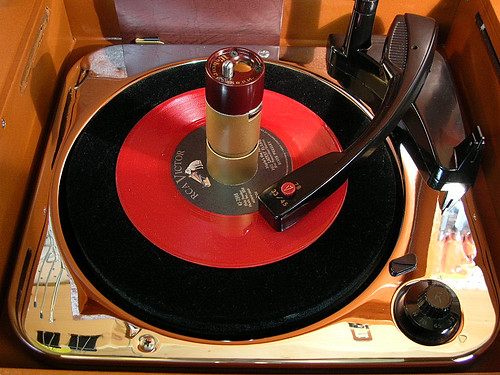 .
.  .
.  .
.  .
.  .
.  .
.  .
.  .
.  .
. 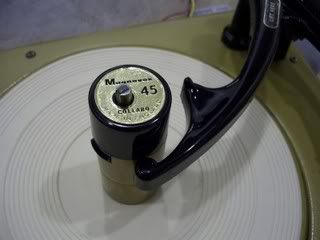 .
.  .
.  .
.  .
. 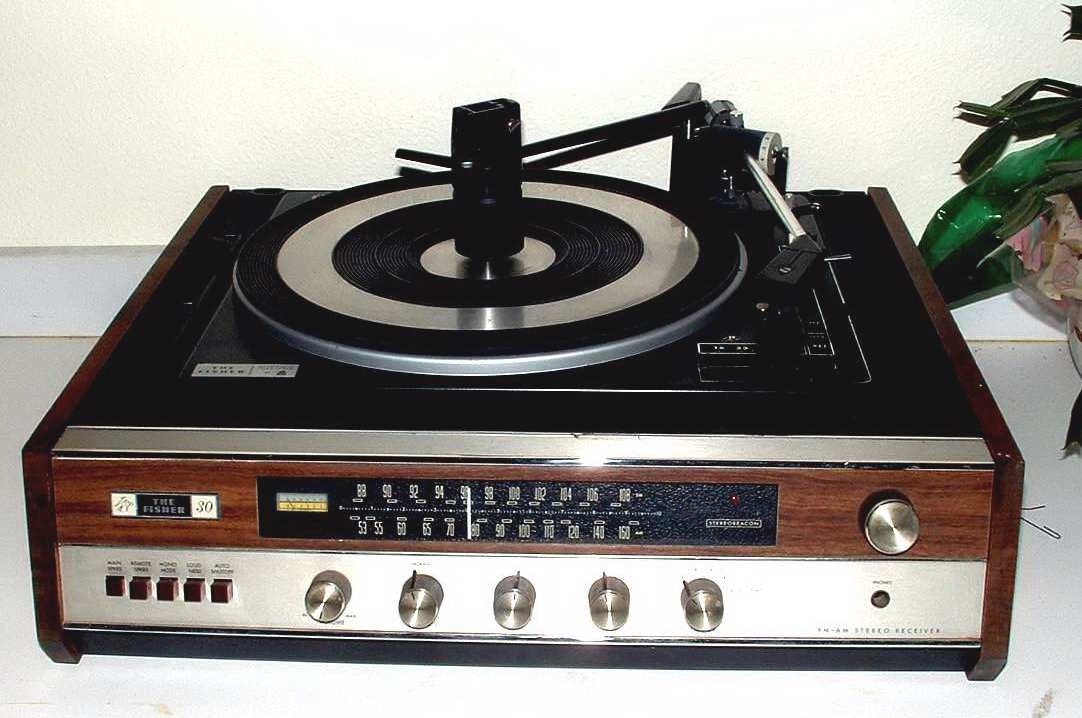 .
.  .
.  .
. 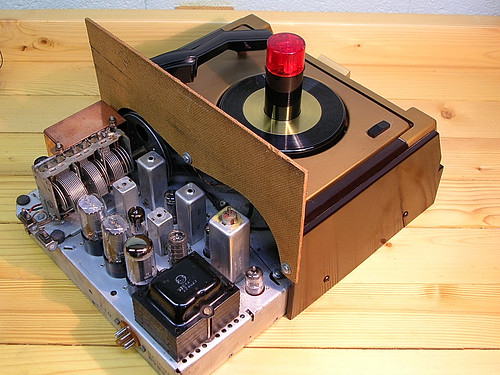 .
. 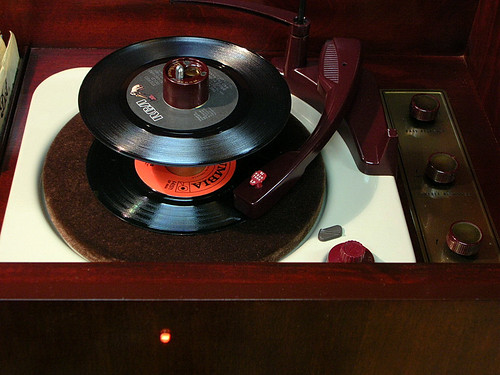 .
. 
Anytime you see these kinds of spindles, that's the kind that require RIAA-specified 7-inch large-center-hole edge thickness of of 0.030 (+/- 0.006) inches (or, At Least, Less Than 0.040 inches thickness, from what I've found with my different brands of stackers):
 .
.  .
.  .
.  .
.  .
.  .
.  .
.  .
.  .
.  .
. 
One can go to youtube and search "45 record changer" and similar searches, and see people playing records on Lots of these.... EACH OF THESE VIDEOS IS FROM A DIFFERENT YOUTUBE USER - Check the video userIDs, not a single repeat in this list: These videos are All From Different People, All Over The Place, and it's just a sampling, there's Tons More on youtube:
 http://www.youtube.com/watch?v=8J70R0t9PA0
http://www.youtube.com/watch?v=8J70R0t9PA0 http://www.youtube.com/watch?v=Z8AGDrhSNNA
http://www.youtube.com/watch?v=Z8AGDrhSNNA http://www.youtube.com/watch?v=f5TzPM2MSOo
http://www.youtube.com/watch?v=f5TzPM2MSOo http://www.youtube.com/watch?v=9alxB7lvd2Q
http://www.youtube.com/watch?v=9alxB7lvd2Q http://www.youtube.com/watch?v=X8inPcgwXi8
http://www.youtube.com/watch?v=X8inPcgwXi8 http://www.youtube.com/watch?v=IrBKH8l1BEU
http://www.youtube.com/watch?v=IrBKH8l1BEU http://www.youtube.com/watch?v=LRyraKvEg98
http://www.youtube.com/watch?v=LRyraKvEg98 http://www.youtube.com/watch?v=VCa-GN6njOs
http://www.youtube.com/watch?v=VCa-GN6njOs http://www.youtube.com/watch?v=Cangs9_UU_o
http://www.youtube.com/watch?v=Cangs9_UU_o http://www.youtube.com/watch?v=ao2v0xuVB2o
http://www.youtube.com/watch?v=ao2v0xuVB2o http://www.youtube.com/watch?v=MdreTVQXEhM
http://www.youtube.com/watch?v=MdreTVQXEhM http://www.youtube.com/watch?v=7mXgVMGivkA
http://www.youtube.com/watch?v=7mXgVMGivkA http://www.youtube.com/watch?v=4XqbukNo_yM
http://www.youtube.com/watch?v=4XqbukNo_yM http://www.youtube.com/watch?v=X9fYe7eR7Wo
http://www.youtube.com/watch?v=X9fYe7eR7Wo http://www.youtube.com/watch?v=xUIu03s3oNY
http://www.youtube.com/watch?v=xUIu03s3oNY http://www.youtube.com/watch?v=89TkE6LZA7I
http://www.youtube.com/watch?v=89TkE6LZA7I http://www.youtube.com/watch?v=B3o6Xrf5RFc
http://www.youtube.com/watch?v=B3o6Xrf5RFc http://www.youtube.com/watch?v=C3DxmMTw460
http://www.youtube.com/watch?v=C3DxmMTw460 http://www.youtube.com/watch?v=R_lO6KJOfI4
http://www.youtube.com/watch?v=R_lO6KJOfI4 http://www.youtube.com/watch?v=eMnRiQ01GbU
http://www.youtube.com/watch?v=eMnRiQ01GbU http://www.youtube.com/watch?v=a9b0JpHlq8E
http://www.youtube.com/watch?v=a9b0JpHlq8E http://www.youtube.com/watch?v=zOn9dSLafSs
http://www.youtube.com/watch?v=zOn9dSLafSs http://www.youtube.com/watch?v=jjBQtEEaTng
http://www.youtube.com/watch?v=jjBQtEEaTng http://www.youtube.com/watch?v=jL8ZvlAfNUM
http://www.youtube.com/watch?v=jL8ZvlAfNUM http://www.youtube.com/watch?v=0hPDaMZUE14
http://www.youtube.com/watch?v=0hPDaMZUE14 http://www.youtube.com/watch?v=31WkJe9GWYk
http://www.youtube.com/watch?v=31WkJe9GWYk http://www.youtube.com/watch?v=NZfY6VSVPXA
http://www.youtube.com/watch?v=NZfY6VSVPXA http://www.youtube.com/watch?v=YmIVfh0wqvg
http://www.youtube.com/watch?v=YmIVfh0wqvg http://www.youtube.com/watch?v=Rngux-BEs3w
http://www.youtube.com/watch?v=Rngux-BEs3w http://www.youtube.com/watch?v=agsHU5abKik
http://www.youtube.com/watch?v=agsHU5abKik http://www.youtube.com/watch?v=x1JyRyvvR38
http://www.youtube.com/watch?v=x1JyRyvvR38...etc, etc.
China is even pumping out these "repro" changers under the "Crosley Stack-O-Matic" brand name:
 .
. 
The blade-slicer automatic large-hole 45 rpm spindle record players, which require RIAA-spec thickness on 45 center hole edges, are iconic, and these players still have a following today.
 .
.  .
.  .
.  .
.  .
.  .
.  .
. 
IN SUMMARY:
Above is the reason why I suggest It's A Good Thing For Plants To CONTINUE to REMAIN Compliant With That Large-Hole 45rpm Spec WHEN POSSIBLE, if selling records to the USA market.
Thanks,
- Bob

 .
. 
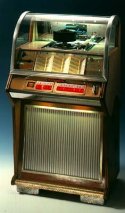 .
.